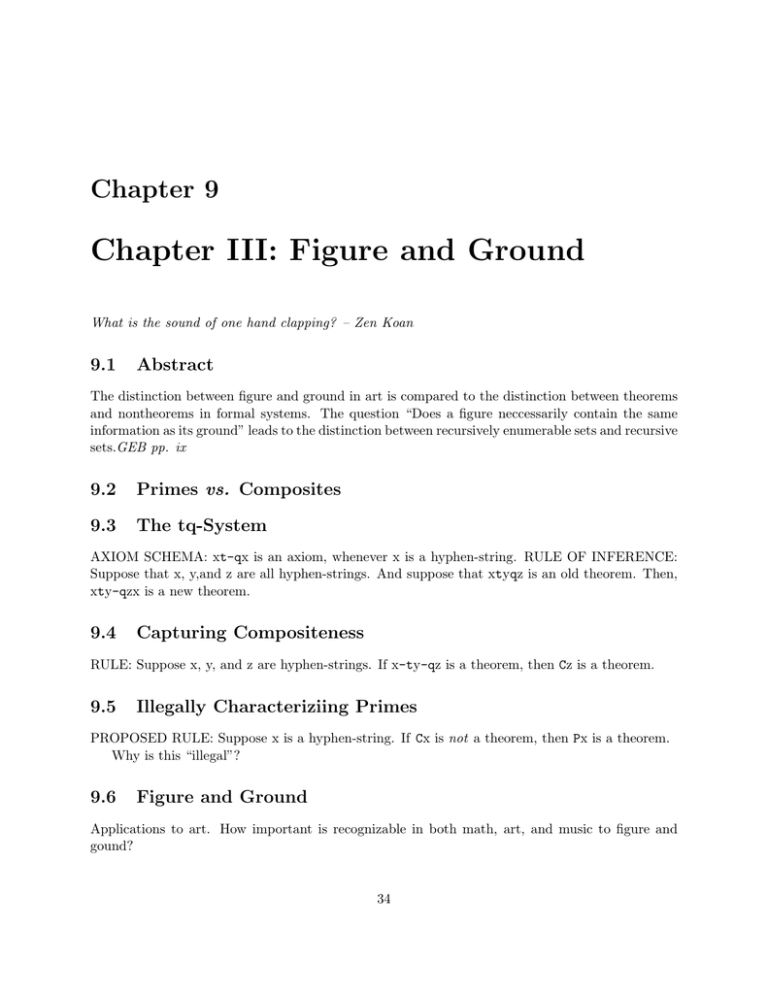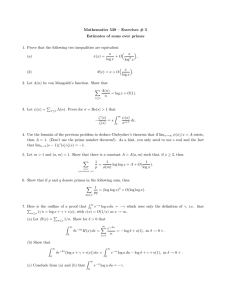Chapter III: Figure and Ground
advertisement

Chapter 9 Chapter III: Figure and Ground What is the sound of one hand clapping? – Zen Koan 9.1 Abstract The distinction between figure and ground in art is compared to the distinction between theorems and nontheorems in formal systems. The question “Does a figure neccessarily contain the same information as its ground” leads to the distinction between recursively enumerable sets and recursive sets.GEB pp. ix 9.2 Primes vs. Composites 9.3 The tq-System AXIOM SCHEMA: xt-qx is an axiom, whenever x is a hyphen-string. RULE OF INFERENCE: Suppose that x, y,and z are all hyphen-strings. And suppose that xtyqz is an old theorem. Then, xty-qzx is a new theorem. 9.4 Capturing Compositeness RULE: Suppose x, y, and z are hyphen-strings. If x-ty-qz is a theorem, then Cz is a theorem. 9.5 Illegally Characteriziing Primes PROPOSED RULE: Suppose x is a hyphen-string. If Cx is not a theorem, then Px is a theorem. Why is this “illegal”? 9.6 Figure and Ground Applications to art. How important is recognizable in both math, art, and music to figure and gound? 34 9.7 Figure and Ground in Music What music is recursive? 9.8 Recursively Enumberable Sets vs. Recursive Sets So what is recursive? It is different than the tool for thinking we introduced a while ago, but still connected. To understand what recursive means, imagine you have a collection of things (a set), and you want to determine out of all things in the universe, which ones are members of that original collection (set). If there is an algorithm or a set of intstructions which can determine membership of a set in finite time, then the set is recursive. The hot tamale is that (GEB pp. 72) There exist formal systems whose negative space (set of non-theorems) is not the positive space (set of theorems) of any formal system. Which stated more formally says There exist recursively enumerable sets which are not recursive and finally that There exist formal systems for which there is no typographical decision procedure. 9.9 Primes as Figure Rather than Ground AXIOM SCHEMA: xyDNDx where x and y are hyphen-strings. RULE: If xDNDy is a theorem, then so is xDNDxy. RULE: If - - DNDz is a theorem, so is zDF - -. RULE: If zDFx is a theorem and also x- DNDz is a theorem, then zDFx- is a theorem. RULE: If z-DFz is a theorem and, then Pz- is a theorem. AXIOM: P - ­ 9.10 Study Questions More specifics... 9.10.1 Primes vs. Composites in the tq- systems 1. Don’t do it, but would you have trouble listing which of the first 30 positive integers are prime numbers and which are composite numbers? 2. Define the tq-system, by naming the (a) legal symbols, (b) axiom(s), and (c) rule of produc­ tion, all in symbolic form. 3. Hofstadter claims that the tq-system is supposed to capture multiplication. Does it? Trans­ late the axioms to arithmetic statements. Translate the three theorems shown on p.65 into arithmetic statements. 4. Why is the rule of inference from of the tq-system arithmetically reasonable? 35 9.10.2 Capturing Compositeness and Illegally Characterizing Primes 1. Hofstadter implicitly introduces a new symbol into the tq-system in order to state a new RULE. What is the symbol, and what is the complete set of allowed symbols for what the new C-system? Are you of the opinion that variables ought to be included in the list? 2. . What is the arithmetic meaning of the new rule, and how does it capture compositeness? Why does the new rule have the two hyphens in it? Wouldn’t x t y q z work just as well to express compositeness? (Think of a special case) 9.10.3 Figure and Ground 1. Comment on the Smoke Signal drawing, p.702, as it relates to what weve done so far. Try to see a message that says “Ceci n’est pas un message” (meaning “This is not a message”). You might also compare this figure with the one on p.494. 2. Consider the definitions of “cursively drawable” (by the way, what would be “cursively un­ drawable” or “uncursively drawable”?) and “recursive” on p.67. Draw a Venn diagram that shows both the relationship between the two and the meaning of the statement on p.68 “There exist cursively drawable figures that are not recursive” 3. What puzzle does Fig. 17 solve? Do you see that it solves it? 4. Explain Figure 18 as you understand it to your roommate, playmate, soul mate, shipmate, or even a random passerby. This is very important! 36 MIT OpenCourseWare http://ocw.mit.edu Gödel, Escher, Bach: A Mental Space Odyssey Summer 2007 For information about citing these materials or our Terms of Use, visit: http://ocw.mit.edu/terms.



